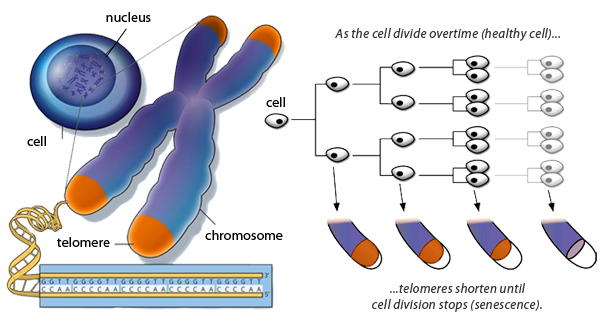Elizabeth Parrish, became the first person to undergo rejuvenative gene therapy in 2015, and results are now out – the procedure successfully lengthened her telomeres by the equivalent of 20 years.
 Of the two therapies she received in 2015, one was telomerase gene therapy which aims to increase levels of the enzyme telomerase which extends telomere length. As you get older your telomeres gradually wear down which compromises stem cell activity, and there have been numerous studies supporting telomere shortening as a major contributor to the aging process. Many scientists believe that correcting the loss could rejuvenate and protect against aging. Telomerase gene therapy in mice had both of those effects, with mice living on average 24% longer. Mice are all well and good, but we need human testing and that’s what Elizabeth Parrish wanted to kickstart.
Of the two therapies she received in 2015, one was telomerase gene therapy which aims to increase levels of the enzyme telomerase which extends telomere length. As you get older your telomeres gradually wear down which compromises stem cell activity, and there have been numerous studies supporting telomere shortening as a major contributor to the aging process. Many scientists believe that correcting the loss could rejuvenate and protect against aging. Telomerase gene therapy in mice had both of those effects, with mice living on average 24% longer. Mice are all well and good, but we need human testing and that’s what Elizabeth Parrish wanted to kickstart.
It worked.
Parrish’s initial telomeres were measured by SpectraCell in Houston and revealed to be unusually short for her age, which placed her at higher risk of age-related disease as a number of studies have hinted that telomere length is a good biomarker of overall health. We all start off with different lengths so the rate of shortening seems to be more important than the overall length, but it still remains a good indicator of disease risk. Parrish underwent gene therapy in September 2015, and in March 2016 the telomeres in her white blood cells were measured again by SpectraCell. They had extended from 6.71kb to 7.33kb, which corresponds to around 20 years of aging. These results were independently verified by UK based charity The Biogerontology Research Foundation, and Brussels based non-profit company HEALES (Healthy Life Extension Company).

Parrish: “Current therapeutics offer only marginal benefits for people suffering from diseases of aging. Additionally, lifestyle modification has limited impact for treating these diseases. Advances in biotechnology is the best solution, and if these results are anywhere near accurate, we’ve made history”
Exciting stuff!
Yes, the results are only on one person and whether the same extension has happened across the body remains to be seen. However, while dosages and details may need refining, there have so far been no ill effects and no-one has ever undergone this kind of procedure before. These initial results are extremely promising, and could really help get the ball rolling worldwide – stimulating more proactive action against aging.
Comentarios